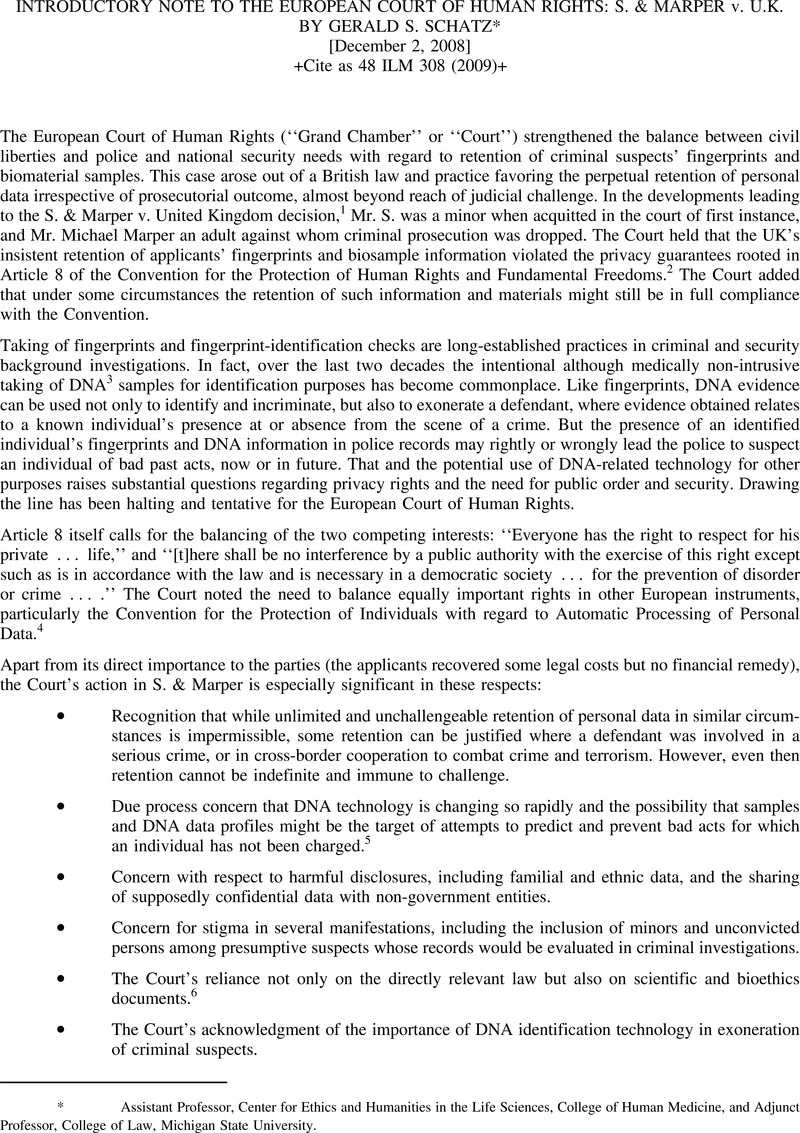No CrossRef data available.
Published online by Cambridge University Press: 27 February 2017

* Assistant Professor, Center for Ethics and Humanities in the Life Sciences, College of Human Medicine, and Adjunct Professor, College of Law, Michigan State University.
* This text was reproduced and reformatted from the text available at the ILM Issuu database: (visited March 10, 2009) <http://issuu.com/i.l.m./docs/s._marper_v._u.k.>
1 S. & Marper v. U. K., App. Nos. 30562/04 and 30566/04 (Eur. Ct. H.R. Dec. 4, 2008), available at http://www.echr.coe.int/ECHR (last visited Mar. 2, 2009).
2 Convention for the Protection of Human Rights and Fundamental Freedoms, Nov. 4, 1950, 213 U.N.T.S. 222 (1953).
3 Deoxyribonucleic acid, distinctive genetic material easily obtained by such methods as mouth swabs; see NY State Task Force on Life and the Law, Genetic Testing and Screening in the Age of Genomic Medicine (2000), available at http://www.health.state.ny.us/nysdoh/taskfce/screening.htm (last visited Mar. 2, 2009). Forensic DNA technology has improved dramatically in the last two decades; compare J.A. McKenna, J.S. Cecil, & P. Coukos, Fed. Judicial Ctr., Reference Guide on Forensic DNA Evidence & Reference Manual on Scientific Evidence (1994).
4 Convention for the Protection of Individuals with regard to Automatic Processing of Personal Data, Jan. 1, 1981, 1496 U.N.T.S. 66 (1981).
5 The science in this area remains speculative; for a still current and authoritative analysis of its implications for law, see Mark A. Rothstein, Impact of Behavioral Genetics on the Law and the Courts, 83 JUDICATURE 116 (1999-2000).
6 Nuffield Council on Bioethics, Forensic Use of Bioinf-ormation: Ethical Issues (2007), available at http://www.nuffieldbioethics.org/go/ourwork/bioinformationuse/publication_441.html (last visited Mar. 2, 2009). See also Evans v. U.K., App. No. 6339/05, (Eur. Ct. H.R. Apr. 10, 2007).
1 DNA stands for deoxyribonucleic acid ; it is the chemical found in virtually every cell in the body and the genetic information therein, which is in the form of a code or language, determines physical characteristics and directs all the chemical processes in the body. Except for identical twins, each person’s DNA is unique. DNA samples are cellular samples and any 4 sub-samples or part samples retained from these after analysis. DNA profiles are digitised information which is stored electronically on the National DNA Database together with details of the person to whom it relates.
2 The Nuffield Council on Bioethics is an independent expert body composed of clinicians, lawyers, philosophers, scientists and theologians established by the Nuffield Foundation in 1991. The present report was published on 18 September 2007 under the following title ‘‘The forensic use of bioinformation: ethical issues’’
3 Allele is one of two or more alternative forms of a particular gene. Different alleles may give rise to different forms of the characteristic for which the gene codes (World Encyclopedia. Philip’s, 2008. Oxford Reference Online. Oxford University Press).
4 The law and practice in Ireland are presently governed by the Criminal Justice (Forensic Evidence) Act 1990. A new Bill has been approved by the Government with a view to extending the use and storage of DNA information in a national database. The Bill has not yet been approved by Parliament.
5 The Legislative Decree of 30 October 2007 establishing a national DNA database was approved by the Italian Government and the Senate. However, the Decree eventually expired without having been formally converted into a Statute as a mistake in the drafting was detected. A corrected version of the decree is expected to be issued in 2008.